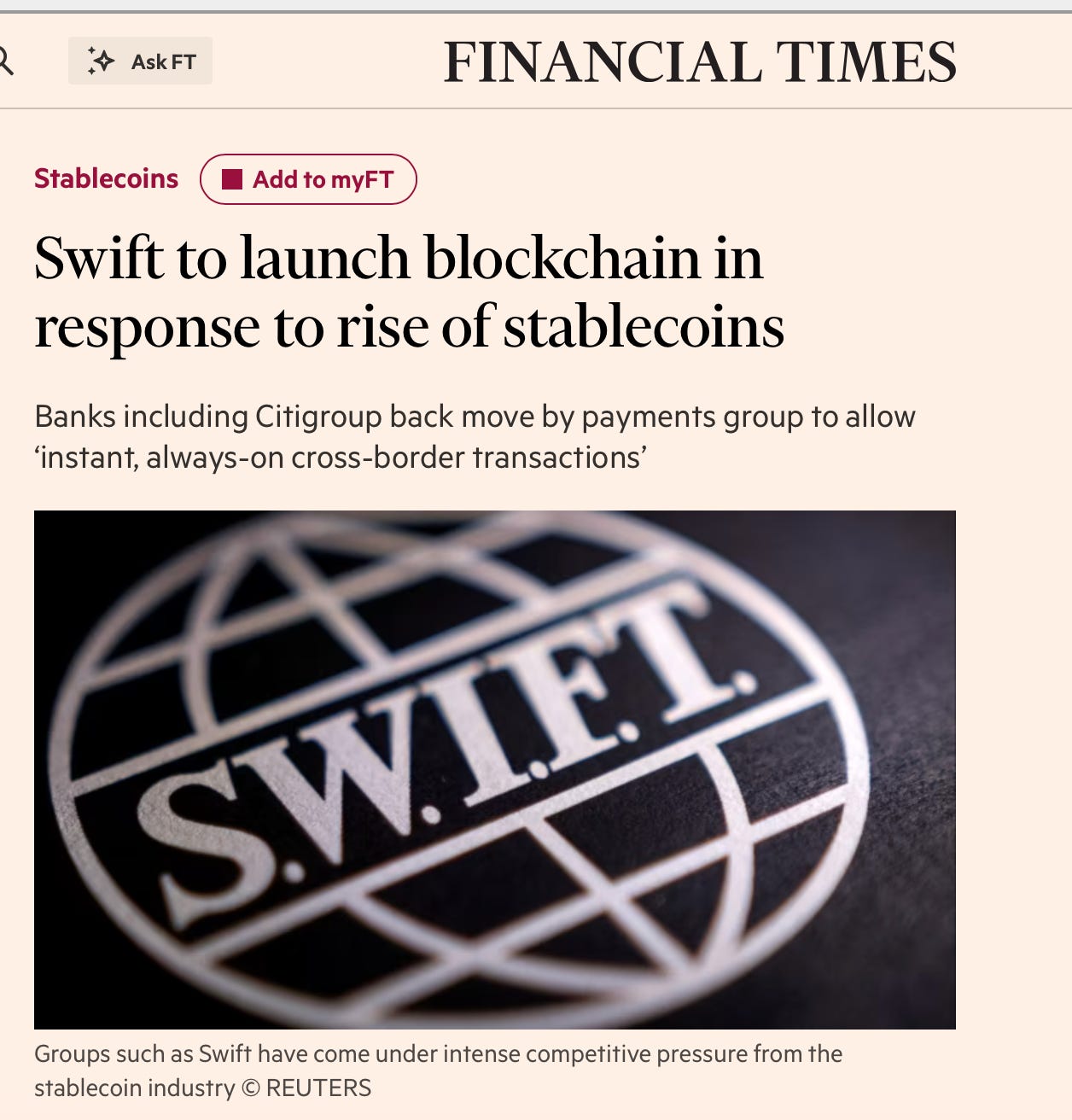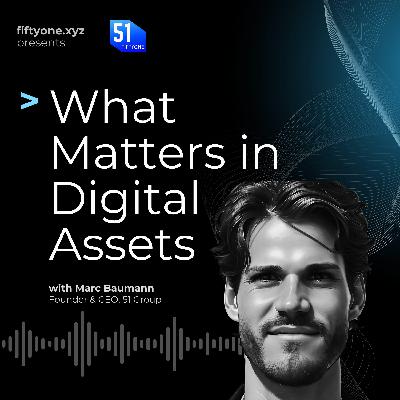147: Everyone has a stablecoin
Description
Hey, it’s Marc.
Token2049, the world’s biggest crypto event, just wrapped in Singapore and this year felt different: stablecoin rails, tokenized treasuries, and prediction markets.
Meanwhile, SWIFT just picked Ethereum to build a blockchain with 30+ global banks. The same network that moves $150T a year is admitting crypto rails are the future.
Stripe just launched stablecoin-as-a-service. Every fintech, exchange, and enterprise can now mint its own stablecoin in a few lines of code. We’re heading toward a world where every major institution issues money. And nobody yet knows what the endgame looks like.
Also this week:
* Cloudflare that controls 20% of the internet launched Internet Money
* Visa Direct will start to prefund payouts with stablecoins
We’ll unpack all of these highlights below.
🚨 We just opened new sponsorship slots for our newsletters & podcast. Want to reach 35k+ digital asset leaders? Contact us here.
Top Boardroom Reads
👉Subscribe to our Crypto Treasury Alpha newsletter here.
* Inside Pantera’s $500M Solana Treasury Play, with Cosmo Jiang (51)
* The stablecoin duopoly is ending (Nic Carter)
* Stablecoins 2030 - Web3 to Wall Street (Citi)
* Crypto treasury in a world of wallets (Ubyx)
* The State of Wealth in 2025 (Fintech Prime Time)
* Fintech 101: The Tokenisation of Real World Financial Assets (Fintech Blueprint)
* Why crypto targets massive markets (Bitwise Asset Management)
🙌 Work with us: We create pioneering thought leadership that helps digital asset and technology companies lead the conversation, earn trust and win business.
Top Signals This Week
SWIFT’s picks Ethereum
SWIFT announced on Sept 29 it will launch a blockchain-based ledger with ConsenSys and 30+ major banks - JPMorgan, HSBC, Citi, BNP Paribas, Deutsche, Santander, Wells Fargo, BNY Mellon, and more. The system will enable real-time, 24/7 cross-border settlements using tokenised deposits and smart contracts. [RELEASE]
Why it matters: SWIFT moves $150T annually through 11,500 institutions. But settlements take 5 days with multiple intermediaries, hidden fees, and manual AML checks. Meanwhile, stablecoins scaled from $20B (2020) to $300B today, processing trillions annually. Banks are losing material cross-border payment share. SWIFT’s move is defensive but necessary.
🚨Upgrade to Pro for our daily CEO Notes & market signals.
Stripe launches stablecoin-as-a-service
What happened: Stripe announced three new products that let any business launch, hold, and use stablecoins with just a few lines of code: [RELEASE]
* Open Issuance: Launch and manage your own stablecoin with reserves from BlackRock, Fidelity, and Superstate.
* Stablecoin Financial Accounts: Hold, convert, spend, and send stablecoins directly from a Stripe account in the US.
* On/Off-Ramp Infrastructure: Move between fiat and stablecoins with local APIs and stablecoin Visa cards in 15+ countries.
Why it matters: For a decade, Circle (USDC) and Tether (USDT) have controlled 85%+ of the $245B stablecoin market. Every challenger — from Terra to Binance’s BUSD, failed to dent that dominance. Stripe just changed the economics. Businesses, DeFi protocols, wallets, and even fintechs can now mint their own “house stablecoins,” capture yield, and own user float instead of passing profits to Circle/Tether. This could fragment the market and accelerate the decline of the old duopoly.
Our take: This isn’t just Stripe going after payments, it’s Stripe offering stablecoin infrastructure as a service. If neobanks, exchanges, and apps adopt Stripe’s rails, the next $200B in stablecoin growth won’t be captured by USDC or USDT but by thousands of custom issuers. Think of it as the Shopify moment for stablecoins: Stripe handles the messy compliance and plumbing; platforms keep the margin. For treasurers, that means yield opportunities. For marketers, it opens the door to brand-owned money. For Circle and Tether, it’s an existential challenge: the float is up for grabs.
Visa Direct will prefund payouts with stablecoins
What happened: At SIBOS, Visa announced a pilot for stablecoin prefunding on Visa Direct. Instead of parking fiat in advance, businesses can pre-fund Visa accounts with USDC or EURC. Visa treats those balances as “money in the bank,” unlocking faster global payouts and reducing working-capital drag. [Release]
So what? By allowing businesses to pre-fund accounts with stablecoins, Visa transforms frozen capital into liquid assets that can be moved in minutes, not days. Visa treating USDC and EURC as “money in the bank” for prefunding signals mainstream trust in stablecoins and enables near-instant cross-border payouts. But this also raises threats for regional banks to lose liquidity and fee-based income from correspondent banking services.
Our take: The real signal isn’t the pilot itself, but Visa treating USDC/EURC like deposits, effectively blurring the line between bank balances and blockchain balances.
Cloudflare launched Internet Money
Cloudflare announced NET Dollar, a US dollar–backed stablecoin designed to power instant, programmable payments for the agentic web. It is positioning its global network as a payments rail for machine-to-machine microtransactions, pay-per-use APIs, and fractional payouts. [RELEASE]
So what? With Cloudflare handling ~20% of all internet traffic, its entry into stablecoins is viewed as a potential turning point in the future of online payments. However, it needs open standards and interoperability (like Google’s Agent Payments Protocol/ Coinbase’s x402), otherwise the ecosystem risks siloing and fragmentation if every cloud/cloud-edge provider issues its own token.
Must watch: Execution. If developer and AI platforms adopt Cloudflare’s token for agent-driven payments and if creators see tangible value in new microtransaction models, it could become core web infrastructure.
Chainlink’s and UBS’ $100T tokenisation bridge
Chainlink and UBS just demonstrated how to manage tokenised funds for workflows like subscriptions and redemptions, directly from existing systems using SWIFT ISO 20022 messages via Chainlink Runtime Environment (CRE). Banks access blockchains through the same S


















